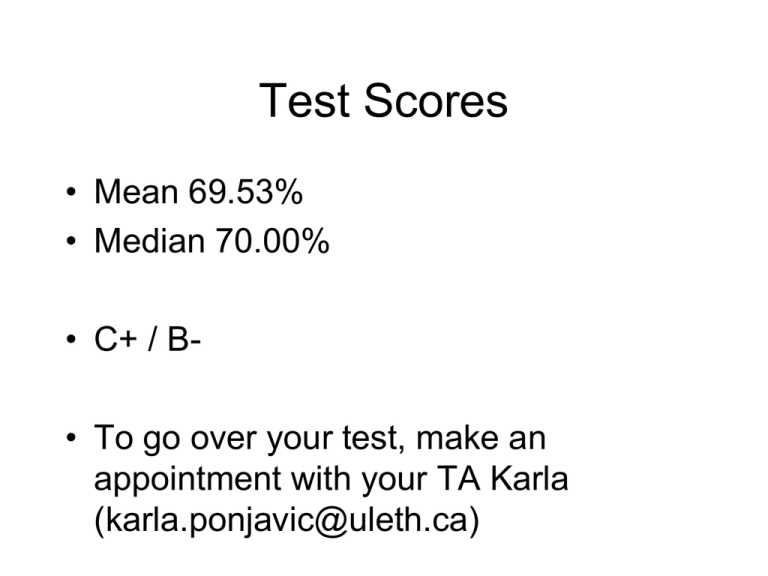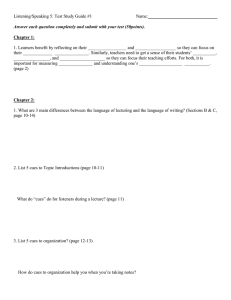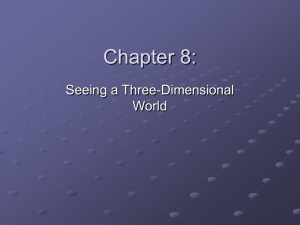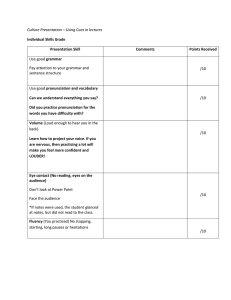Test Scores
advertisement

Test Scores • Mean 69.53% • Median 70.00% • C+ / B- • To go over your test, make an appointment with your TA Karla (karla.ponjavic@uleth.ca) Upcoming: Read article by Gregory for February 10th Read chapter by Pinker for February 17th Read article by Land for March 3rd Seeing Depth • The world is 3D, the retina is 2D ! Depth Cues • Four categories: 1.Pictorial 2.Physiological 3.Motion 4.Stereoscopic Pictorial Depth Cues – Shadows and Shading: visual system assumes light from above Pictorial Depth Cues – Shadows and Shading: visual system assumes light from above Pictorial Depth Cues – Shadows and Shading Pictorial Depth Cues – Shadows and Shading Pictorial Depth Cues – Retinal image size – far objects smaller than near objects Pictorial Depth Cues • Retinal image size – problem: big far things same as close small things – “solved” by size constancy: Perceived size is adjusted according to perceived distance (based on other cues) – forms the basis for several visual illusions Pictorial Depth Cues • Retinal image size Pictorial Depth Cues • Retinal image size Pictorial Depth Cues • Linear perspective Pictorial Depth Cues • Texture gradient Pictorial Depth Cues • Height in the plane More Depth Cues • • • • Pictorial Depth Cues Physiological Depth Cues Motion Parallax Stereoscopic Depth Cues Physiological Depth Cues – Two Physiological Depth Cues 1. accommodation 2. convergence Physiological Depth Cues – Accommodation Physiological Depth Cues – Convergence Physiological Depth Cues – Convergence – small angle of convergence = far away – large angle of convergence = near – – What two sensory systems is the brain integrating? What happens to images closer or farther away from fixation point? Physiological Depth Cues – Convergence and accommodation are reflexively linked Under what circumstances might this be a problem? Motion Depth Cues – Motion 1. Parallax Motion Depth Cues – Parallax Motion Depth Cues – Parallax – points at different locations in the visual field move at different speeds depending on their distance from fixation Depth Cues Pictorial Depth Cues: aspects of 2D images that imply depth Physiological Depth Cues: Proprioception in ocular muscles indicates accommodation and convergence Motion Depth Cues: foreground and background move in opposite directions Stereoscopic Depth Cues: disparity between two retinal images indicates distance Illusions related to depth perception • Misperceptions of size • Misperceptions of location Muller - Lyer Illusion Muller - Lyer Illusion Muller-Lyer Illusion • What theory does Gregory take up? Muller-Lyer Illusion • What theory does Gregory take up? – Thiery / Woodworth : Muller-Lyer figure “suggests perspective” Muller-Lyer Illusion • What theory does Gregory take up? – Thiery / Woodworth : Muller-Lyer figure “suggests perspective” – Is there something about the presence of pictorial depth cues in an image that distorts size? Depth Cues and Size Distortion The Ponzo Illusion: Depth Cues and Size Distortion The Ponzo Illusion: Depth Cues and Size Distortion • The illusion of depth in an image seems to distort the perception of size in the image • This is due to misapplication of Size Constancy Pictures are Weird • What does Gregory find paradoxical about pictures? Pictures are Weird • What does Gregory find paradoxical about pictures? Pictures convey depth yet also appear flat Why? Pictures are Weird • When you view a picture there are some depth cues telling you to perceive depth, but other cues telling you that the image is on a flat surface • …the surface matters! Pictures are Weird • Retinal image size Pictures are Weird • Retinal image size The Apparatus • What does he do to remove the paradox so that the Muller-Lyer figure no longer looks flat? • Remove the background surface The Apparatus Removing the Background • With background removed, Muller-Lyer figure actually looks 3D • What prediction can you make about how the perceived size and the perceived distance of the center line are related? Removing the Background • With background removed, Muller-Lyer figure actually looks 3D • What prediction can you make about how the perceived size and the perceived distance of the center line are related? When the centre line appears close,it should also appear small When the centre line appears far, it should also appear large Removing the Background • How did Gregory test that? The Apparatus Removing the Background • Perceived size and perceived distance are tightly related • inward arrowheads make line look closer / outward arrowheads make line look farther Seeing Seeing in in Stereo Stereo Seeing in Stereo It’s It’svery veryhard hardtotoread readwords wordsififthere there are aremultiple multipleimages imageson onyour yourretina retina Seeing in Stereo It’s It’svery veryhard hardtotoread readwords wordsififthere there are aremultiple multipleimages imageson onyour yourretina retina But how many images are there on your retinae? Binocular Disparity • Your eyes have a different image on each retina – hold pen at arms length and fixate the spot – how many pens do you see? – which pen matches which eye? Binocular Disparity • Your eyes have a different image on each retina – now fixate the pen – how many spots do you see? – which spot matches which eye? Binocular Disparity • Binocular disparity is the difference between the two images Binocular Disparity • Binocular disparity is the difference between the two images • Disparity depends on where the object is relative to the fixation point: – objects closer than fixation project images that “cross” – objects farther than fixation project images that do not “cross” Binocular Disparity • Corresponding retinal points Binocular Disparity • Points in space that have corresponding retinal points define a plane called the horopter The Horopter Binocular Disparity • Points not on the horopter will be disparate on the retina (they project images onto non-corresponding points) Binocular Disparity • Points not on the horopter will be disparate on the retina (they project images onto non-corresponding points) • The nature of the disparity depends on where they are relative to the horopter Binocular Disparity • points nearer than horopter have crossed disparity • points farther than horopter have uncrossed disparity The Horopter Binocular Disparity • Why don’t we see double vision? Binocular Disparity • Why don’t we see double vision? • Images with a small enough disparity are fused into a single image Now on to Magic Eye Stereograms Stereograms Divider Left Eye Right Eye •Right eye sees face to the left; left eye sees face to the right therefore: faces present crossed disparity to the brain •Face appears in front of square Autostereograms • Optically separate images aren’t needed Autostereograms • Optically separate images aren’t needed • WARNING! Tricky stuff coming in the next slides Autostereograms • Uneven spacing between identical objects in a single picture can appear as disparity if the angle of convergence is inappropriate • TRICK: Seeing depth in autostereograms requires you to suppress the reflexive coordination between convergence and accommodation Autostereograms Any repeating objects that have a spacing different from the background will have either crossed or uncrossed disparity RIGHT EYE LEFT EYE If you uncross convergence, your right eye gets these faces shifted slightly to left, left eye gets them shifted to right = CROSSED DISPARITY What would you see? Autostereograms Any repeating objects that have a spacing difference from the background will have either crossed or uncrossed disparity RIGHT EYE LEFT EYE If you uncross convergence, right eye gets these faces shifted slightly to right, left eye gets them shifted to left = UNCROSSED DISPARITY What would you see? Autostereograms • by adjusting the disparity at different parts of the image (with a computer usually) one can make shapes that emerge or recede in depth “Magic Eye” Stereograms • Usually viewed with uncrossed convergence • Imagine gazing farther than the surface (let your eyes “relax”) • Now try to notice objects or forms in the blurriness • As you become aware of shapes, try to focus (accommodate) the plane of the image without converging your eyes Autostereograms Autostereograms Autostereograms


